Babywearing Safety
![]()
by Beth Beaney, Executive Babywearing Consultant & Co-Founder, LTBN
First thing’s first - carrying your baby is normal. Carrying a baby with a sling or carrier ('babycarrying' or 'babywearing') is practiced all around the world today. Humans have been carrying babies in slings throughout history. Simply put, our babies expect to be carried, and we are made to carry them.
Your Baby Needs To Be Carried
Regardless of the fact that the baby in the picture above looks like he's giving us all the middle finger, I'm loving his vibes. He's happy being carried. And your baby will be happy being carried too.
Here are the top 6 reasons why:
- Carrying your baby helps develop a secure mutual attachment.
- It allows both parents (or indeed any caregiver) to develop a deep bond with baby.
- It increases parental sensitivity to a baby's needs - you learn to interpret their little noises and expressions so much quicker.
- It simulates the sensations of pressure, motion, warmth and security of the womb.
- Carrying your baby in a sling reduces their level of stress.
- It can greatly reduce crying and fussiness, and also helps your tired baby fall asleep.
In my experience, a sling or carrier is an absolutely necessary element in your parenting 'toolkit'.
I honestly don't know how any parent copes without one.
At the end of the day, it enables you to meet your baby's needs (all of them - emotional, psychological, physiological) whilst still having your hands free to do what you need to do.
Not only that, but the bottom line is that it's liberating, empowering and wonderful!

Sling Safety
Carrying your baby in a sling is a beautiful way to bond and make a deep connection.
It also enables you to get on with the everyday - whether it's UN-style negotiations with other children, or just a getting a hot cup of tea, having your baby in a sling or carrier can make that all so much easier.
Carrying your baby or toddler in a sling is perfectly safe when practiced with common sense and understanding. As with all things in life a cupful of knowledge and a sprinkling of common sense is the best recipe to ensure happy carrying for you and your little one. Use a quality carrier and ensure you read the instructions on its use.
As a Trageschule UK and Slingababy trained Consultant, I can help answer any questions regarding sling safety that you have, and I'm always happy to help you on your carrying journey.
We promote slings and carriers that provide optimal comfort, support and positioning for your baby and for you.
You can learn more about babywearing safety by checking out the T.I.C.K.S. Rules for Safe Babywearing, and the ABC guide courtesy of Babywearing International below.
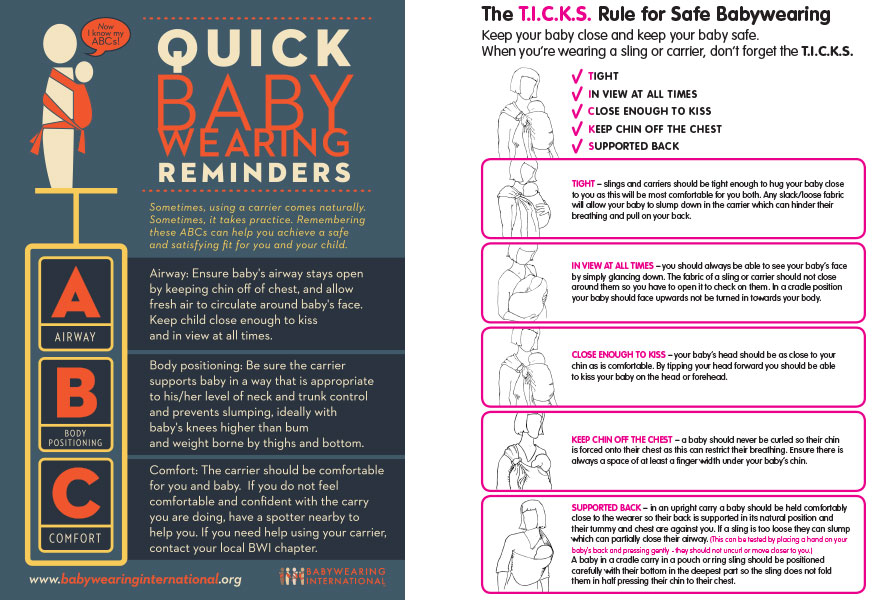
Babywearing Basics
Babywearing starts with safety & comfort, both for you and baby.
Here are our 8 top tips for babywearing comfortably and safely.
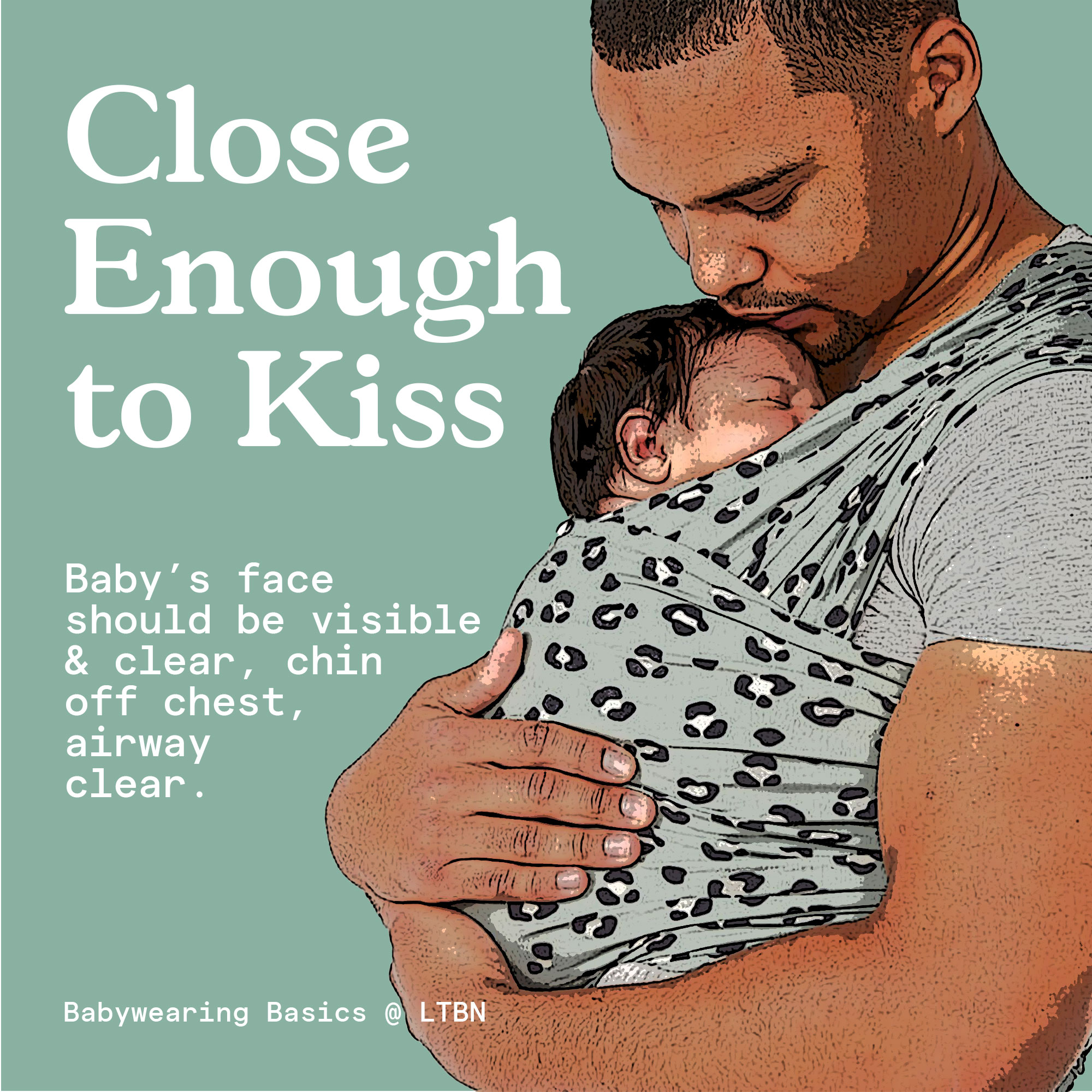
1. Close Enough to Kiss
Everything starts with safety and comfort, so in this series of infographics, we’re starting at the beginning. From this grows confidence and you'll be babywearing like a pro in no time!
Ensure baby is seated so their head is free and clear of your chest, so their head is above your chest.
Visibility is key - make sure you can see baby’s face; make sure their chin is off their chest.
You don’t want their face obscured, covered or pushed down in any way.
In a nutshell: Baby’s face should be visible & clear, chin off chest, airway clear.

2. In View at All Times
Many (in fact probably most) parents start babywearing with a little nervous trepidation. I know I did.
Is baby safe? Is baby comfortable? Is this even the right thing to be doing!?
You just need to make sure baby is in view at all times.
You should always be able to see baby’s face by simply glancing down.
Don’t cover baby’s face or allow them to become obscured by the sling or clothing.
Remove chunky scarves and such.
Your sling or carrier is a tool - use it properly and you'll get tonnes of use from it.
In a nutshell: You should always be able to see your baby’s face by glancing down.

3. Head Free & Clear
Your baby should be in view, even in a buckle carrier.
So you have a newborn, or are about to have one. You’re looking for a carrier. Great stuff.
You’ve narrowed it down to one. You’ve bought it. Amazing.
Here’s the wee nubbin of info to remember... your baby’s head should be free and clear of the carrier.
What, even with a structured carrier?! Yes, even with a carrier.
If baby’s head is hidden by the top of carrier, then it either needs adjusted on your body or if it’s already sitting at the best spot on your body, then it just may not fit you and/or your newborn.
In a nutshell: Newborn buckle carriers will not fit every body & every baby.
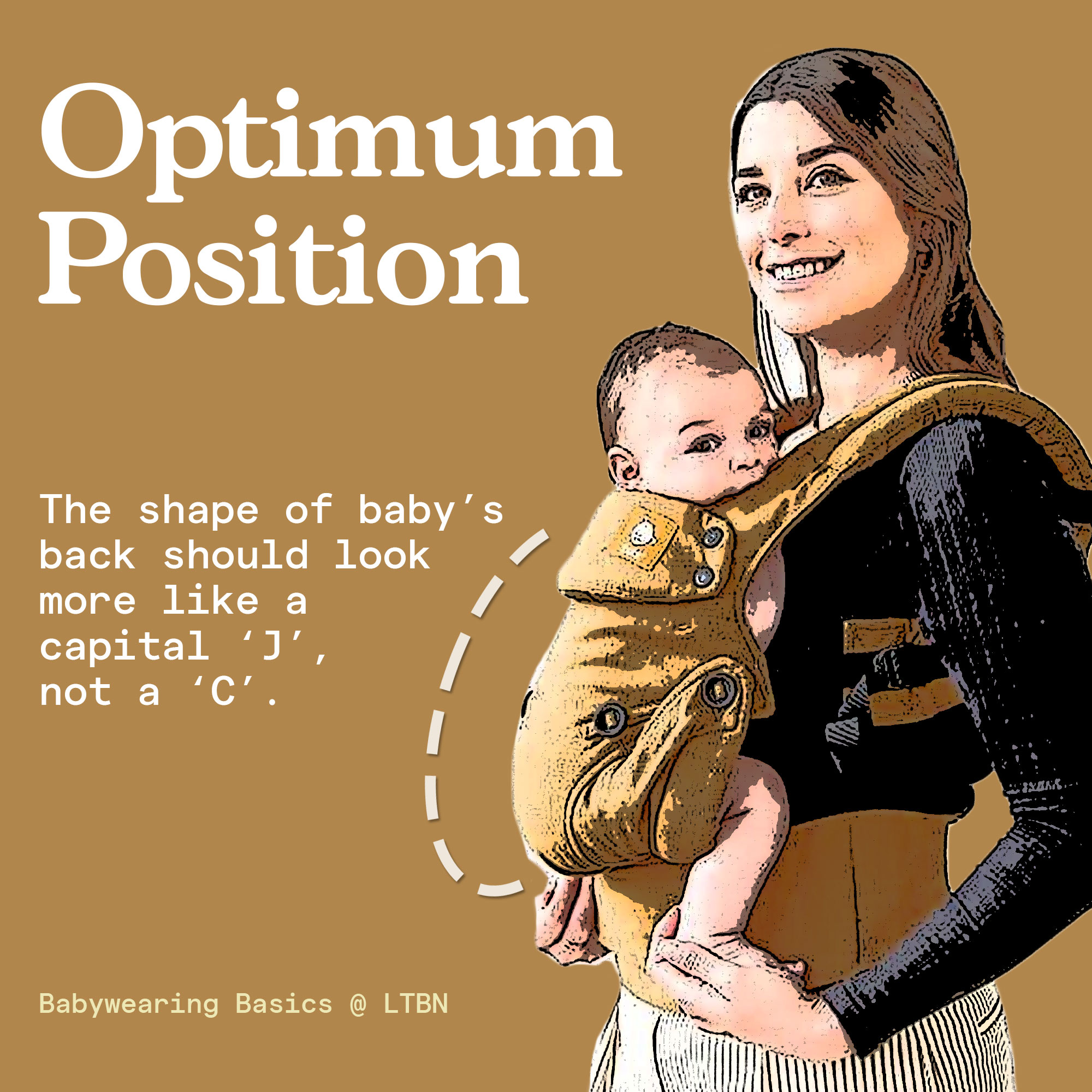
4. Optimum Position
Baby should not be seated in a ‘C’ shape. Not ever.
Look at the shape of a ‘C’ - the curl at the top. If your baby (particularly a younger baby) is seated in a ‘C’ shape, it’s likely they are at least slightly slumped.
Keep baby’s head free and clear of the carrier and their seated position more like a capital ‘J’.
Capital ‘J’ - knees tucked up at the hook of the ‘J’, around the curve of their bottom and an almost straight spine. Soft, yet supported.
In a nutshell: The shape of baby’s back should look more like a capital ‘J’ not a ‘C’.

5. Hands Up
A question that comes up so often: 'where do baby's arms go?'
Ideally, baby's arms should be up in front of their body for support. It helps support their spine & lifts their head up.
From a sensory perspective it allows baby access to their hands; some baby's like to sleep on their hands or fists, and for some it's an early feeding cue - bringing a hand to their mouth.
In a nutshell: Baby’s arms should be tucked up in front of them.
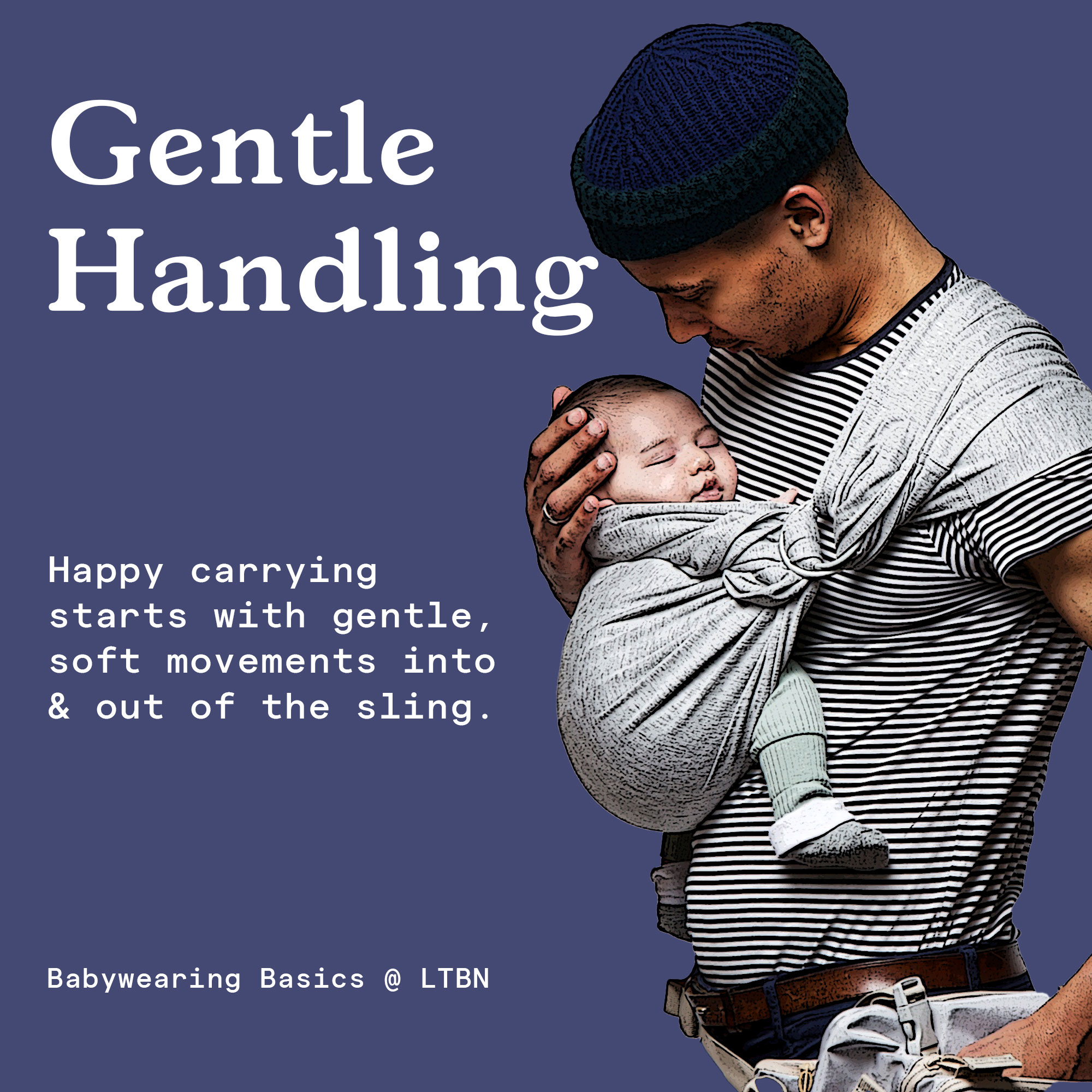
6. Gentle Handling
In my experience as a Babywearing Consultant, I often find that the most important part of carrying happens before the sling.
It makes sense - the sling is a tool you use to maintain that loving touch, that connectivity whilst being mobile and active.
So the movements and handling before the sling are important.
Gentle movements and soft handling can make all the difference. Support baby's newborn physiology. Slow, reassuring movements. Take your time. Deep breaths. In through your nose. Fill your lungs.
It will be a much more pleasant experience for you both if you can avoid overly-firm, sudden and jerky movements.
In a nutshell: Happy carrying starts with gentle, soft movements into & out of the sling.

7. Be Comfortable
Many parents are nervous when they start babywearing for the first time, constantly checking if baby is safe and comfortable, yet with little regard for their own comfort.
Is baby safe? Is baby comfortable? As important as these things are (and they are), never underestimate the importance of your own comfort!
If your sling leaves you in pain, or is uncomfortable to use then realistically, you are less likely to use it. This totally defeats the purpose of a sling or carrier.
Your post-partum body is not the body you once knew. It's done something marvellous, so show it some empathy. Pain when carrying isn't necessarily a 'normal' part of carrying. It may well have more to do with your sling than your body.
If you’re in any doubt, ask our experienced, caring babywearing consultants.
In a nutshell: Babywearing is as much about your comfort as baby’s.
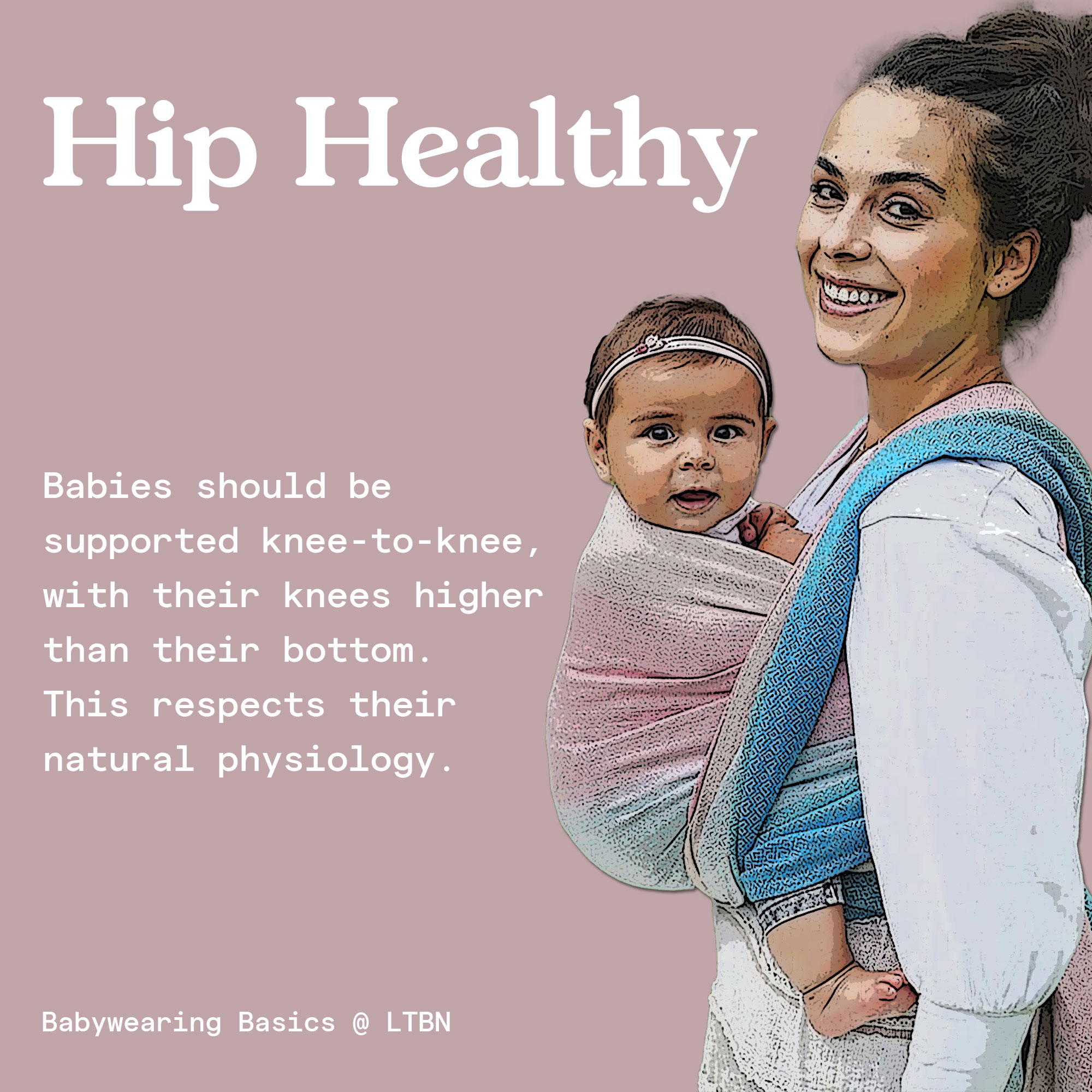
8. Hip Healthy
I'm often asked ‘Will this damage their hips?’, or ‘Is this ok for their hips?’, or 'What about their hips!?'
Generally speaking, a good carrier should support baby in the ‘hip healthy’ position.
This position is also called 'M' shape - knees higher than their bottom and with the sling or carrier fully supporting them from the back of one knee across to the other knee.
This position respects baby’s natural physiology. In fact it’s the same position babies will adopt when having an upright cuddle in arms.
This is most important for newborns and younger babies (although not unimportant for older babies).
In a nutshell: Babies should be supported knee-to-knee, with their knees higher than their bottom.This respects their natural physiology.
What To Wear When Babywearing
This is important in the context of babywearing safety as carrying your baby in a sling when it's particularly warm or especially cold takes a little bit of extra thought.
Always be aware of and responsive to your baby's needs for safety and comfort. You should always refer to the TICKS safe babywearing guidelines (above).
In warm and cold weather remember:
1. One layer of sling is equal to one layer of clothing. Even when it's cold, you don't need to bundle baby up in a snowsuit-type outfit. There is a natural heat exchange between you and baby which will help keep baby warm.
2. Cover / protect head, feet, legs and hands.
3. Choose comfortable, light clothing, preferably made from natural fibres.
4. Carry baby as close to you as possible, with as few layers between you as possible.
Babywearing In Winter
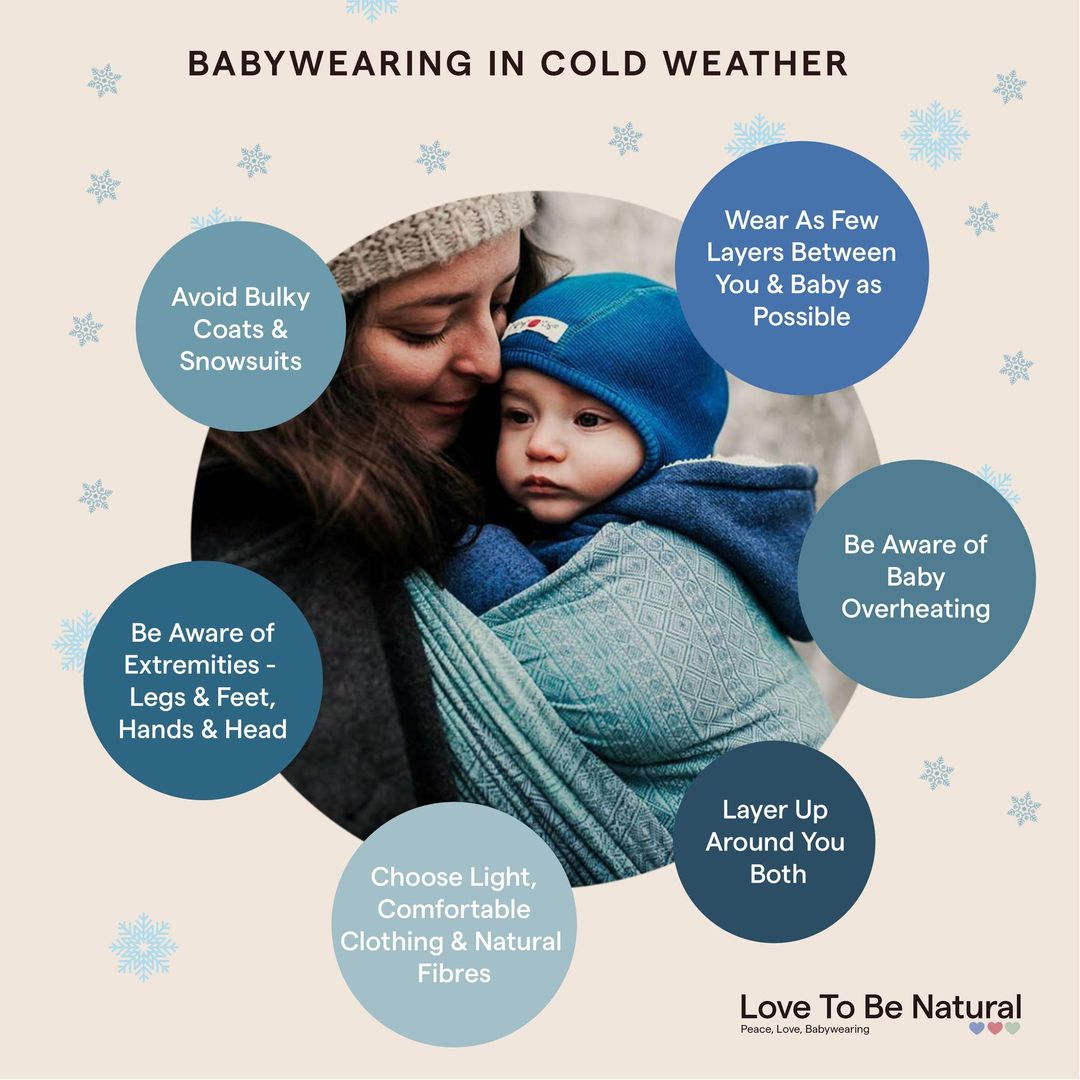
8 Top Tips for staying safe & warm in cold weather:
- Keep as few clothing layers between you and baby as possible. Babies regulate their temperature best when they are closest to you. The natural heat exchange between you both occurs best with fewer, lighter layers; natural fibres help too.
- Do not use bulky coats and snowsuits on baby; such bulky layers can lead to baby overheating, particularly in younger babies. Older babies can end up with a layer of sweat against their skin which can leave them chilled.
- Pay extra attention when putting baby in your carrier. Imagine baby in a coat, then imagine you are wrapping them, or lifting the panel of a baby carrier up their back - (visualise the process) - the coat will often end up riding up baby's back and sitting higher than normal. When baby then relaxes or falls asleep their face could potentially be completely obscured by the coat, and their airway could become compromised.
- Avoid snowsuits for optimal positioning. It's very difficult to achieve that lovely soft, open, raised knee position in a snowsuit - it just doesn't allow for the flexibility of baby's limbs, and doesn't respect their physiology.
- It's amazing how warm you both stay when carrying, especially when walking and being out and about. Baby's trunk will stay toasty warm, especially younger babies in stretchy wraps - remember to count the layers of a sling as layers of clothing!
- Be aware of extremities - I know this sounds obvious, but when the weather turns icy, or when it's that chilly damp weather that clings to your bones, remember to cover up little noggins (something that covers the ears too if it's windy), hands if they're exposed, and the lower legs and feet. Think an extra pair of socks / leggings / tights / legwarmers - anything that will add warmth but that can be removed if needed.
- Layer up around you both. There are lots of options, such as babywearing coats, jackets or covers which make it really easy to get out and about in cold weather, but which are equally easily removed when you go indoors.
- Have fun! There's no better place for your little one to experience the change of the seasons - the colours, sights and smells - than from the comfort of a sling, tucked up all snug and safe right next to you.
Babywearing In Summer
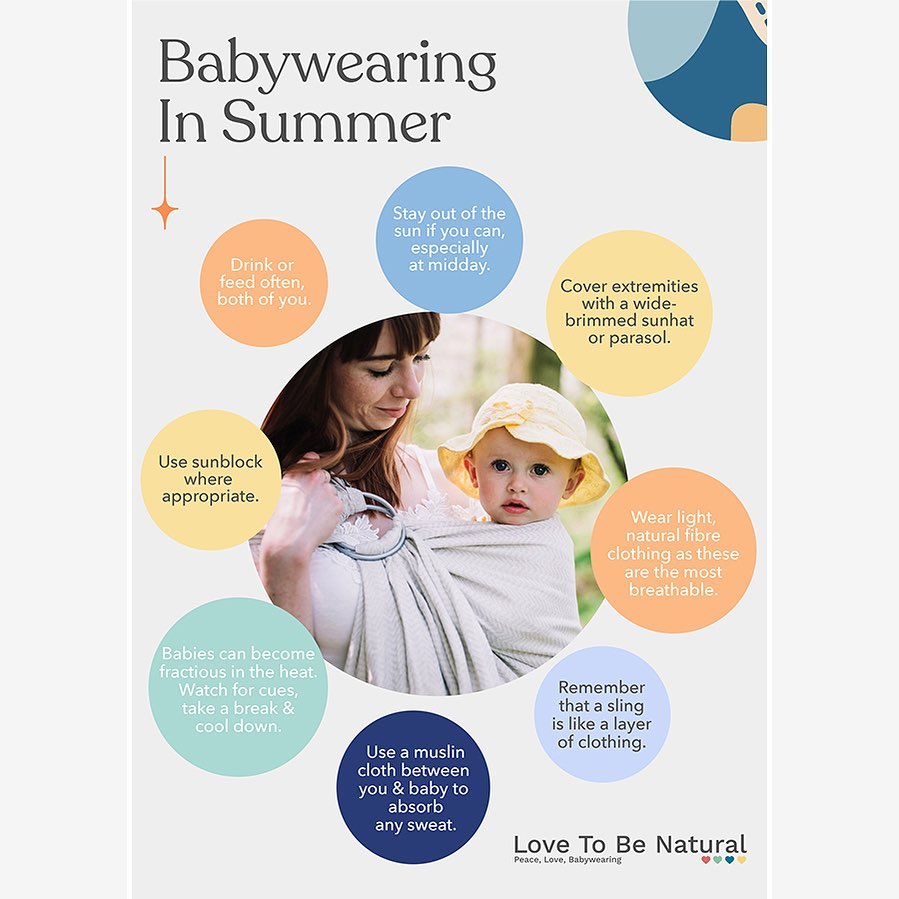
And here are our 8 top tips for staying safe and cool when babywearing in summer:
- Drink or feed often, both of you.
- Stay out of the sun if you can, especially at midday.
- Cover extremities with a wide-brimmed hat or parasol.
- When light, neutral coloured clothing made from natural fibres as these are the most breathable.
- Remember that a sling is like a layer of clothing, so adjust what you're wearing accordingly, but make sure you're still covered up.
- Use a muslin cloth between you and baby to soak up any excess sweat.
- Babies can become fractious in the heat (as can you!) - watch for these cues, take a break and cool down.
- Use sunblock where appropriate.
There are some carriers that are more suited to carrying in hot weather. Our babywearing experts have hand-picked the best baby carriers for summer to help you choose a summer infant baby carrier.
How To Care for Baby Carriers
This might not seem like an immediately obvious topic in the context of babywearing safety, however it is important to care properly for your carrier in order that you minimise damage to it.
Each manufacturer has their own specific guidelines for washing and care instructions. Do read the care guidelines that come with your carrier. Some wraps that are made of silk, wool, alpaca, or cashmere, will require particular attention.
As a general guide, we definitely suggest washing your carrier / wrap / sling as seldom as possible. Spot clean any marks if you can. We always suggest using an eco detergent, always non-biological, and no softener. When washing a ring sling, it's a great idea to put it in a pillowcase first - this will protect the drum your washing machine from being damaged by the rings of the sling.
Air-dry your sling, either indoors or out. If line-drying, pop a sock between the peg and the wrap / sling to prevent peg marks.
I hope you found this article helpful. Please get in touch or email me - beth@lovetobenatural.co.uk - if you'd like any further info carrying your baby safely or babywearing best practices.
Beth Beaney is the Founder of and Executive Babywearing Consultant at LTBN. She's been a qualified babywearing consultant for 12 years, and has helped hundreds of families of all needs all over the world carry their babies safely and comfortably. Find her on Twitter @lovetobenatural_LTBN
 5,467 Reviews
5,467 Reviews